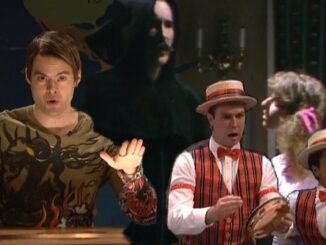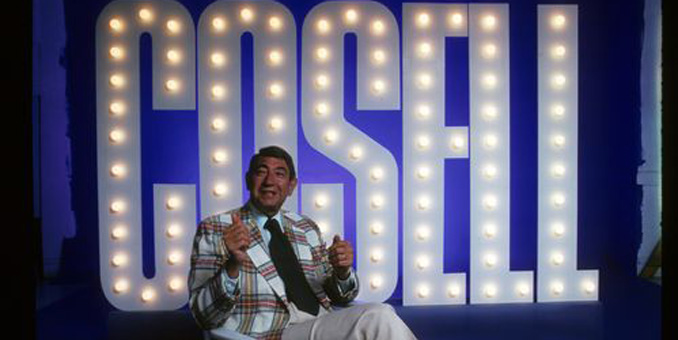
In the fall of 1975, the media was abuzz about a new variety program. It was meant to be a new spin on the variety shows of old. It would be aired live from New York City every Saturday night from one of the most historic theaters in town. It would feature music by the hottest acts of the day. It would feature sketches from a group of players that would include Bill Murray, Christopher Guest and Brian Doyle Murray. And it would be hosted each and every week by sports journalist Howard Cosell.
Oh, what? Did you think I was talking about NBC’s Saturday Night Live? The TV series that is currently celebrating its 50th year? No, I’m talking about its non-so-direct competition. I’m talking about a show that jumped out of the gates first and staked claim to the name Saturday Night Live with Howard Cosell, causing the NBC show we are celebrating this year to start its run as NBC’s Saturday Night. It wouldn’t get to use its recognized name until May 1977. But by that time, Saturday Night Live with Howard Cosell was consigned to the dustbin of history. Or it would be if it wasn’t for its connection to the far more popular version of Saturday Night.
Before we talk about that other Saturday Night Live, we should probably introduce you to the man whose name is attached to it. Howard Cosell died in 1995. That means there are two generations of people who have little or no knowledge of the man. Some might consider these people lucky to not have that knowledge.
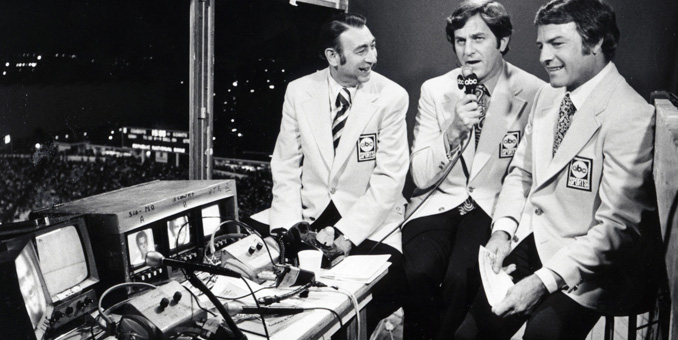
Howard Cosell was one of the most polarizing figures in pop culture of the 1960s and 1970s. He rose to prominence due to his association with Muhammad Ali. Cosell supported Ali after he changed his name from Cassius Clay and when he refused to report to the selective service draft. He became synonymous with ABC Sports, handling their baseball and boxing coverage and is probably most known for being in the Monday Night Football booth from its inception until 1983.
People typically fell into three camps when it came to Cosell: they either loved him, hated him, or loved to hate him. And each camp carried that love or hatred passionately. For those in the latter two camps, Cosell was a pompous egotist would never use two words to describe something when he could do it in 15. And those 15 words would be peppered with $20 words that most people would need a dictionary to understand. His easily imitated staccato way of speaking only added to peoples’ annoyance with him. Compounding that, Cosell was never one to shy away from using his platform to air his opinions, usually in the most smug and egotistical way possible. That didn’t win him any fans either.
It is not unusual to have someone from the world of sports commentary move over to the worlds of news and entertainment. Bryant Gumbel and Bob Costas did it, just to name two. But typically, the people who make the move fall more on the “liked” side of the “liked/dislike” divide. But while Cosell might not have had the type of personality to be the joyful and buoyant host of a variety program, he held a much more valuable asset: he was the favorite of Roone Arledge, the powerful head of ABC Sports. ABC Sports made a lot of money for the network in 1975, and, as such, Arledge could do pretty much whatever he wanted. And if he wanted Howard Cosell to host a variety show, Howard Cosell would host a variety show.
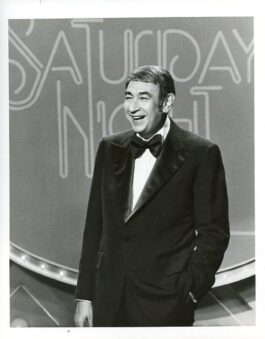
Arledge thought they public’s love him or hate him approach to Cosell would work in his favor. “Some people do love him, and they’ll watch him. Others won’t ever watch, and still others will tune in hoping to see him fall on his face. Howard’s a wise guy, and some people would love to see that happen.”
The idea for the variety show came from two other times that executives tried to recruit Cosell to host one. According to Cosell, an executive at NBC tried to lure the sportscaster away from ABC with the promise of his own variety program. Cosell didn’t bite. ABC came to him with a variety show idea, but he didn’t like the format. Instead, he sat down with Arledge and worked to create variety show they could see themselves doing.
They wanted a variety show in the mold of The Ed Sullivan Show. They wanted it housed in New York City because Cosell thought variety shows produced on the West Coast were “a piece of plastic with a floating crap game of guests.” They even chose the Ed Sullivan Theater as the show’s home.
Where Cosell and Arledge decided to break away from the typical variety show format was in the use of satellite technology, then prevalent in the world of sports broadcasting, which would open up the world for acts and the coverage of news stories. Yes, that’s right, instead of just focusing on entertainers, the show would cover the world of news and, naturally, sports during its episodes, using the satellite technology at their disposal. “If Sinatra gets into a fuss in Australia,” Cosell said, “we’ll be there. If Fanne Foxe jumps into the tidal basin, we’ll have her on the show.”
(If you, like me, were wondering who Fanne Foxe was, she was an Argentine American stripper who got caught up in a sex scandal in 1974 when it was revealed that she was having an affair with then-Arkansas Congressman Wilbur Mills. How the affair was discovered was that Foxe was riding in the same car as Mills when it was pulled over for a traffic stop. In a futile attempt to escape being discovered, Foxe left the car and jumped into the tidal basin in the West Potomac Park in Washington, D.C. Foxe’s memoir. The Stripper and the Congressman, was released the same month Saturday Night Live with Howard Cosell debuted.)
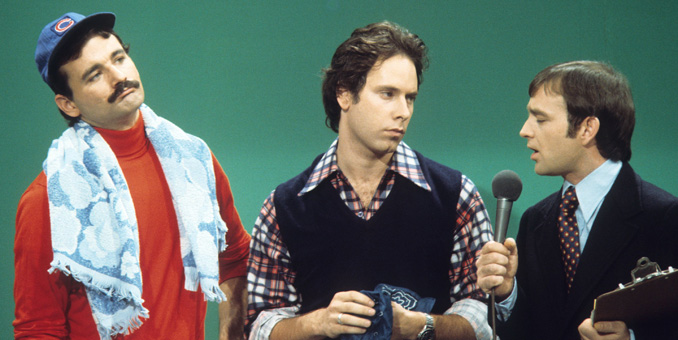
Cosell had hoped that he would have the newsmakers on themselves to interview about the news they were making, but if that couldn’t happen, he’d have a troupe of actors to fill in and play the newsmakers instead. The troupe would be called “The Prime Time Players” and would feature Bill and Brian Doyle Murray and Christopher Guest in their number. If you ever wondered why the original cast of NBC’s SNL was called “The Not Ready for Prime Time Players,” it was meant to be a thumbing of the nose at Cosell’s cast. The name is made more ironic considering the three men mentioned above would eventually join the cast of NBC show.
It is obvious that ABC felt strongly about the show. The network gave the show a 20 episode commitment at the 8pm Saturday time slot and a per show budget of $250,000. To put that budget in perspective, in today’s dollars, adjusted for inflation, it would come out to over $1.4 million per episode. That is a staggering amount of money for a scripted show, let alone a variety show.
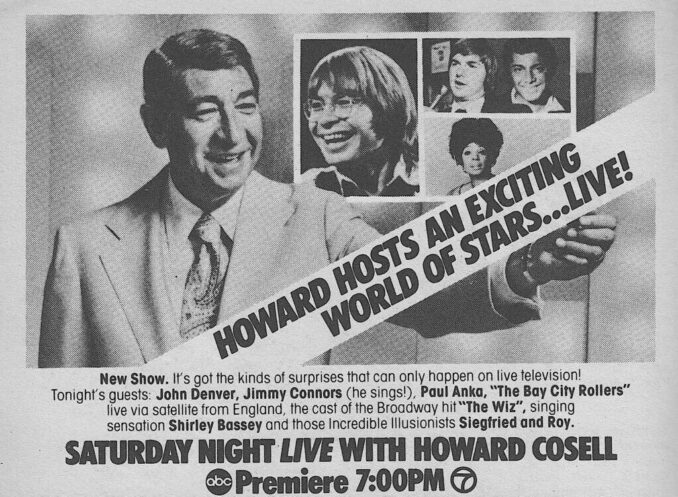
The budget was on display from the very first show. The first episode opened with the cast of The Wiz, one of the most popular musicals on Broadway at the time, marching down Broadway, following a yellow line painted in the road, singing “Ease On Down The Road” as they made their way to the Ed Sullivan Theater (New York City closed down part of Broadway and painted the yellow line to make this happen. I assume part of the $250,000 budget went to help pay for this, because NYC was in the grips of a rather severe financial crisis at the time.)
From there, the show featured a walk on by Frank Sinatra for some witty banter, a song sung by Shirley Bassey, a film clip featuring the Beatles from 1961, and the Scottish rock band the Bay City Rollers making their live U.S. debut via satellite from London. And that was just the first fifteen minutes! If you stuck around for the rest of the hour, you’d see a performance by John Denver of his song “Calypso,” a magic trick by Sigfried and Roy via satellite from Las Vegas, and the singing debut of tennis legend Jimmy Connors. singing “Girl, You Really Turn Me On,” a song written especially for him by Paul Anka. That might be the most 1970’s sentence I have ever written.
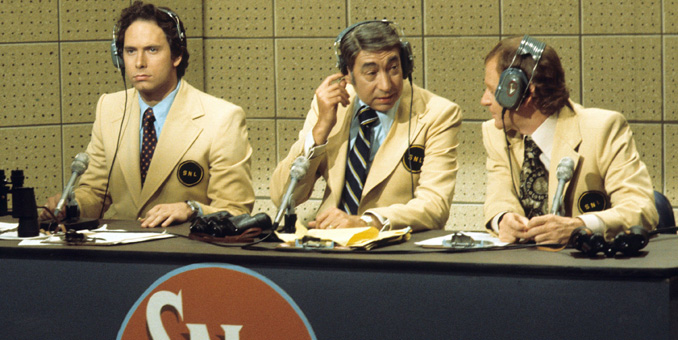
The debut got middling reviews. Barbara Holsopple of the Pittsburgh Press thought the show was “over packed” and over planned, resulting in a lack of spontaneity that you’d expect from a live broadcast. The New York Times John O’Connor also criticized the lack of spontaneity but gave good marks for the show’s technical aspects. The Chicago Sun-Times Gary Deeb took issue with the extraordinary amount of lip-syncing and pre-recorded music on a supposedly “live” program. “Saturday Night Live with Howard Cosell ABC’s New Variety Hour, is every bit as fraudulent as the host,” Deeb wrote.
But as harsh as the critics might have been, the audience response was far worse. Arledge was about 66% wrong about who would be watching. He was right about the people who would never watch not watching. But he was wrong about the people hoping he’d fail tuning in, as well as Cosell’s fans watching. Neither of those two groups showed up. The debut episode ranked as the 63rd out of 70 shows in the Neilson ratings for the week. Saturday Night Live with Howard Cosell was an unmitigated flop.
It would be only natural to blame the failure of the show on Howard Cosell, but the previous tenant of the theater. Ed Sullivan had a very successful show without being Mr. Personality. And you can’t fault the guests, at least at the beginning. Denver had a top ten song on the radio, “I’m Sorry,” while he was on the show. The next week, 9/27, Cosell had on the Eagles, who at the time had the #3 album in the country with One of These Nights. So, they were popular guests.
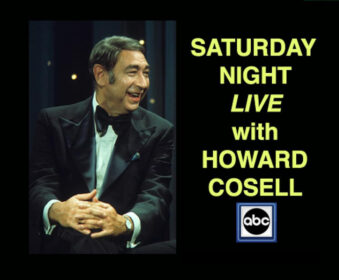
If I was to wager a guess, I could think of some other reasons why the show failed. First of all, Saturday Night Live with Howard Cosell arrived at a time where prime time had a glut of variety shows and just when the format was going out of favor. There were variety shows on the various networks’ schedules hosted by Sonny and Cher, Donny and Marie Osmond and Johnny Cash. And out of all of those, the highest rated of them all was Sonny and Cher, which clocked in at #22 for the year.
The show was also scheduled during Saturday night primetime, a notorious dead zone in American television. And it was scheduled up against two very successful shows: The Jeffersons on CBS, a top 21 show and Emergency! on NBC, a Top 40 show. It had an uphill climb even before The Wiz started easing on down the road.
Saturday Night with Howard Cosell aired its last episode on January 17, 1975. It barely limped to 18 episodes, with three of its last four episodes being rebroadcasts of previous weeks. The last two unaired episodes of the commitment were earmarked for two specials at a future date. The show ended up as the 63rd rated show out of 64 shows at the end of the year.
NBC’s Saturday Night debuted on October 11, 1975. It became a cultural phenomenon while Saturday Night with Howard Cosell became the punchline to many a joke of the day. The NBC show took over the Saturday Night Live name in March of 1977 as the Cosell show started to fade from memory. The NBC cast lost the “Not-Ready for Prime Time Players” name after the 1977-1978 season as “The Prime Time Players” started to fade into obscurity. Saturday Night Live became one of the most honored shows in the history of television while Saturday Night with Howard Cosell became a footnote in it, completely overshadowed by its one-time competition.



